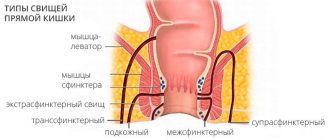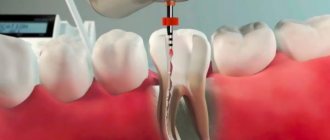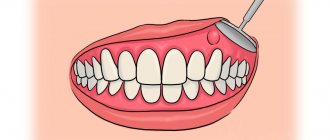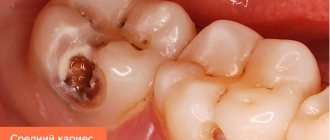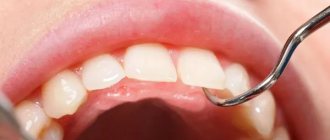On October 20, 2016, the owner of an animal (Chihuahua dog, age 10 years) came to the veterinary clinic “Svoy Doctor”, Kotelniki branch, with a complaint of a lump under the eye on the left side of the muzzle, on the upper jaw. Also, according to the owner, complaints about lethargy and loss of appetite and bad odor from the mouth
When examining the animal, the body temperature was 38.7. Visible mucous membranes are pale pink. During auscultation, wheezing and pathological noises are not auscultated. The animal's condition is satisfactory. When examining the site of compaction, there is an immature abscess of the soft tissues of the upper jaw.
When examining the oral cavity, there is abundant deposition of tartar on the teeth (molars) of the upper and lower jaws + severe trauma to the gums. Also, upon examination and an attempt to remove deposits on the teeth, it was found that the roots of two teeth were exposed, had practically no connection with the jaws and were very inflamed.
What is flux
Flux or periostitis is purulent inflammation of the periosteum. Typically, severe inflammation develops, in which the infection from the diseased tooth spreads to the surrounding tissue (periodontium) and jaw bone. It is characterized by severe pain, swelling of soft tissues, and the accumulation of large amounts of pus.
Typically, the dog will have asymmetrical swelling of the face or painful swelling at the site of the lesion.
In the absence of adequate treatment, the flux can develop into an abscess or diffuse phlegmon.
There are acute and chronic courses of the disease.
Causes:
- mouth infection;
- tooth inflammation;
- tooth injury;
- severe inflammation of the gums;
- inflammation of periodontal pockets;
- tartar.
It should be remembered that tartar, which so often forms in our pets, contributes to the enlargement of gum pockets (the space between the tooth and gum). It seems to move the gum away from the tooth.
This leads to chronic inflammation of the gums, and also creates favorable conditions for the development of infection.
Hair, pieces of food, and foreign objects (for example, chips from chewing sticks) get stuck in the resulting cavity, and subsequently a focus of inflammation is formed.
Signs: swelling of the muzzle, swelling of the cheeks; loss of appetite, refusal to eat; lethargy; fever during an acute process.
In agreement with the owner, a decision was made to remove (extract) two teeth (molars) under local anesthesia.
The manipulation was successful; the areas of suppuration and inflammation were treated with antiseptic solutions and anti-inflammatory drugs.
The owner was given further recommendations on oral care
A week later, the owner came back for a re-examination without any complaints, only a small wound remained at the site of inflammation.
You should be careful about the condition of your pet's oral cavity. If you experience bad breath, tartar, or discoloration of your teeth, it is best to undergo a preventive examination by a specialist.
Source: https://www.svoydoctor.ru/vladeltsam/poleznoe/klinicheskie-sluchai.html?show=1677
Adamantinoma
It is a neoplasm of epithelial tissue, such as enamel, that has not differentiated to the extent that enamel can form. It develops either at the gingival margin (peripheral ameloblastoma, manifested by epulis) or from within the bone (central ameloblastoma). Some of the central ameloblastomas appear as cystic lesions within the bone. Although biologically this tumor is benign and does not metastasize, locally it is extremely infiltrative and aggressive, causing extensive bone resorption, tooth displacement and even resorption of tooth roots.
Oral disease - gumboil
Dogs often develop oral diseases. In most cases, this occurs as a result of the fact that their owners do not properly monitor and care for the animal’s oral cavity. Basically, such cases end with dogs developing tartar, but an equally rare pathology is periostitis, or in other words, gumboil.
Flux in a pet is an inflammatory disease that starts from the gums and progresses to the periosteum. If the disease is advanced, jaw deformation is observed, teeth fall out, and sepsis may begin.
During this disease, the animal feels severe toothache. When the disease is even slightly advanced, even then the animal in most cases loses its teeth. The dog's muzzle may swell, or it may remain unchanged.
Types of disease
There are four types of gumboil in dogs:
- The first type is serous periostitis, the cause of which in most cases is mechanical trauma to the jaw. This type of disease is relatively easy. Swelling of the jaw and periosteum may be observed.
- The appearance of purulent formations on the jaw, in particular on the dog’s gums, indicates that the periostitis is acute and purulent. The animal loses its appetite, behaves quite restlessly, and is in poor general health.
- Diffuse is the most severe and dangerous form of this disease. It is impossible to see individual fluxes, since purulent inflammation spreads along the gums and periosteum. If the disease is not treated, it turns into sepsis. Therapeutic actions during this form are very complex.
- One of the rarest forms of this disease is chronic flux. It can develop in animals that have a weak immune system. And their immunity cannot withstand the ongoing processes in pathology.
If an inflammatory process of this type in a dog occurs on the lower part of the jaw, then it is not very dangerous. But when at the top, then it is necessary to show the pet to a specialized specialist at the veterinary emergency center. Because such a flux can turn into tissue phlegmon, and if the stage is very advanced, even into meningitis.
What reasons can trigger the appearance of periostitis in a dog?
The causes of periostitis in a dog may be the following:
- Dog oral infections;
- Inflammatory process of the tooth;
- Injury to the tooth;
- inflamed gums or periodontal pocket;
- The appearance of tartar.
Symptoms of the disease
- The animal loses its appetite, even if it eats only a little and at first glance you can understand that something is bothering it and causing inconvenience;
- The dog's restful sleep is disturbed, it whines and behaves restlessly;
- Teeth begin to loosen, this is the case if the disease is advanced;
- Blood can be found in a water vessel;
- An unpleasant odor emanates from the mouth, in which the “aroma” of pus is felt;
- There is swelling in the mouth;
- The animal regularly has a flow of saliva. Breeds such as the bulldog salivate quite profusely;
- The animal does not allow its head to be touched;
- It becomes noticeable that the pet eats only on one side;
- If the disease has spread to the upper jaw, it can also reach the nasal cavity. As a result, the animal regularly suffers from bleeding, which is not motivated by anything.
Diagnosis
At the first of the above symptoms, you must urgently contact a veterinarian, where experienced specialists will examine the animal, make a diagnosis and prescribe effective treatment.
The veterinary center's strongholds are located throughout Moscow. If it is not possible to take your pet to the center, then you can call a specialist at home.
Prevention measures
For the health of your four-legged friend, do not forget about preventive recommendations. Oral problems can be easily avoided by:
- Regular teeth cleaning
. Buy toothpaste with meat flavor to reduce mistrust of this unpleasant procedure. Ordinary gauze soaked in a soda solution is also suitable for cleaning.
- Proper combination of hard and soft foods
. Abuse of the first type is fraught with increased bleeding of the gums, and the second - the formation of tartar, loosening of the gums and subsequent tooth loss. Special chewing toys sold in pet stores are also suitable for cleaning plaque.
- Annual examinations at the veterinary clinic
. For dwarf breeds, the frequency of visits should be doubled, as they suffer more than others from dental diseases.
If tartar forms, contact your veterinarian immediately. Plaque can be eliminated using ultrasonic cleaning, preventing the development of complications.
Periostitis is a dangerous disease fraught with many complications. Despite this, it is quite easy to treat at the initial stage. To detect pathology, you need to carefully monitor your pet’s behavior, trying not to lose sight of even the most minor changes.
The article is for informational purposes only. Contact your veterinarian!
Do you like the article? 205
What to do when your dog has flux
Periostitis can form not only on the jaw, but also in various parts of the body (bones of the leg, arm, etc.), and when it appears specifically on the jaw, then the designation for this disease is flux.
The danger of flux is that if not treated properly, the pus sac may rupture and the pus will spread throughout the body, which can lead to a more serious illness in the body.
The process of flux formation itself begins from inflammation provoked by infection in the area of the tooth root, where the initial pus is formed, which gradually makes its way through the bone, and then soft (gums) tissue, escaping. On the outside there is a lump.
In children and the elderly, general symptoms are not as pronounced as in adults, because... their immunity is weakened by other common common diseases.
- With improper medical care, the abscess can periodically rupture on its own, and all symptoms will go away, but inside the tooth and bone tissue the inflammation continues, so improvement in the condition is only a temporary phenomenon.
- There are a sufficient number of reasons for the appearance of flux, because... The teeth themselves, to put it simply, are constantly “at work”, and accordingly, if not properly cared for, are susceptible to various diseases.
- Most often, an infection is to blame for the occurrence of gumboil: particles of putrefactive decay accumulate in the tooth cavity or gum along with food debris during chewing. From the top of the tooth, the pus makes a channel in the bone tissue, trying to escape, and breaks through the bone, stopping under the periosteum of the upper or lower jaw.
- Oral diseases are quite common in dogs. This is often due to the fact that owners do not monitor the condition of their pets’ oral cavity. Most often, the matter ends with the formation of tartar, but gumboil in dogs is not such a rare pathology.
- What is meant by this term? This is an inflammatory disease. Common people believe that the center of inflammation is in the gum, but everything is much more serious. The pathology is localized in the periosteum (periostitis), and therefore the disease is very dangerous, since in advanced cases it is fraught with jaw deformities, tooth loss, and sepsis.
The disease is always accompanied by acute toothache ; if it is even slightly neglected, the dog will almost certainly be left without a tooth.
However, if you yourself have encountered gumboil, then you yourself know about it. It is generally accepted that flux is accompanied by swelling of the face (muzzle in this case), but this is far from the case.
Very often, outwardly everything remains unchanged. Divided into four main types:
Serous. Most often it develops against the background of mechanical injuries to the jaw, occurs relatively easily, and is accompanied by some swelling of the jaw. The periosteum swells noticeably.
Acute purulent periostitis. By the way, this particular form is actually called “flux”, as it is accompanied by the formation of visible abscesses in the gum area. The process (especially in the initial stages) is extremely painful, the dog feels bad, refuses to eat and drink, and is very restless.
The most severe and dangerous type of periostitis is diffuse. In this case, individual localized abscesses are not visible; purulent inflammation spreads throughout all tissues of the gums and periosteum. It proceeds very hard, in neglected
Tooth decay in dogs is decay of the animal's teeth. For what reasons this disease appears is not yet clear.
Predisposing factors for caries in dogs: tooth fracture, tartar, insufficient innate strength of dental substances such as enamel, cement and dentin. The development of caries is often observed in dogs that have had canine distemper.
Caries in dogs is divided into complete caries, in which the crown of the tooth is completely destroyed; deep caries - exposed pulp; average and superficial. The development of caries can begin from the pulp itself.
Symptoms of tooth decay in dogs
- If the caries is superficial, then the lesion is treated with a solution of silver nitrate. The processes are deeper and require removal of the affected teeth.
- Dental pulpitis is located in the root of the tooth, or rather, in its canal. It consists of lymphatic, blood vessels and nerve plexuses that provide nutrition to the dog’s tooth. Inflammation of pulpitis occurs as a result of its exposure as a result of caries, tooth fracture, premature abrasion of the dental crown, and various inflammatory processes.
- Chronic and acute pulpitis, purulent and aseptic, granulomatous and gangrenous are observed. It is extremely difficult to diagnose pulpitis in a dog, since there are no direct symptoms. The animal tries not to use its teeth on the painful side. Tapping a sore tooth causes pain in the dog.
Gangrenous pulpitis is determined by the tooth, which becomes dark brown in color, and the internal cavity of the tooth is filled with pus. Granulomatous pulpitis is characterized by a chronic course in which tissue grows and begins to protrude through the dental opening. If the dog exhibits asepsis
Source: https://halkanpes.ru/post/9868-chto_delat_kogda_u_sobaki_flyus
Symptoms at different stages of the disease
At the initial stage, behavioral changes appear. The pet often comes to the feeder, but due to pain, eats only on one side or spits out the food while chewing. A similar situation occurs with water, since the pain covers the entire jaw.
The serous form is accompanied by swelling of the jaw and swelling of the periosteum. At this stage, the pain is tolerable, so sleep disturbances and increased anxiety are not observed. Snoring may occur.
With the appearance of pus, sores appear on the gums. The entire oral cavity becomes very swollen and red. The cheek on the affected side swells. There is profuse salivation and increased body temperature.
When transitioning to the diffuse form, the animal constantly fiddles with its muzzle, whines and sleeps poorly. The mouth has an unpleasant rotten odor and often bleeds blood, which can be found in bowls of food and water. Teeth become loose and begin to fall out. When the infection enters the nasopharynx, the symptoms are complemented by nosebleeds.
First aid and treatment at home
ethnoscience
Odontogenic periostitis is a serious disease that requires timely diagnosis and proper treatment, since the consequences of this process can be disastrous. If not treated in a timely manner, it can cause blood poisoning, which has a risk of death.
There are also surgical methods for getting rid of this disease, which involve making incisions in the gums to extract the contents of the abscess.
There are many effective methods for treating gumboil at home using traditional medicine recipes. Many doctors respect and even recommend using some of them, but only after visiting a doctor's office.
- A decoction of oak bark – 10 g, nettle leaves – 10 g, calamus rhizomes – 10 g. and sage leaves - 8 gr. The mixture of herbs should be poured into a liter of boiling water and left in a water bath for one hour. Rinse your mouth after 1.5-2 hours;
- Mixture of knotweed and plantain – 40 g. knotweed and 20 gr. add two cups of boiling water to the plantain. After a few hours, strain the mixture and drink three times a day. Used to enhance the effect of other medications.
- Propolis has a strong anti-inflammatory effect, and also relieves pain caused by flux. Propolis tincture is diluted in half a glass of boiled water and used for rinsing; it can be applied to the gums in the form of lotions.
Antibiotics
Antibiotics for flux are the simplest, but at the same time effective option to stop the purulent-inflammatory process that has begun. Let's look at the features of using antibiotics for flux, the most popular drugs, methods of taking them and storage conditions.
Antibiotics for flux are one of the available and reliable ways to prevent the spread of purulent infection. The appearance of flux is always accompanied by inflammation and complications, so treatment of the disease must be approached in a comprehensive manner. Antibiotics will help in treatment, as they affect the entire body due to their wide spectrum of action.
But how to choose the right antibiotics, and which ones are best to take. The most popular are Amoxiclav and Doxycycline.
These drugs have a complex effect on the source of infection and prevent its spread throughout the body. But do not forget that taking antibiotics for flux is not a panacea.
Therefore, after the inflammation has subsided, you need to see a dentist and treat the tooth and gums.
Treatment of flux with antibiotics is used in dental practice, as this is an excellent way to calm the inflammatory process and prevent the spread of infection throughout the body. They are used in flux therapy and the treatment of other dental diseases; antibiotics are especially often used after tooth extraction.
Can complications arise?
If you promptly seek help from a veterinarian and treat your dog in accordance with his instructions, you will be able to avoid complications that arise from inflammation of the lymph nodes in animals. If this is not done, the functioning of the entire lymphatic system will be impaired, which means that the pet will lose the natural barrier that protects it from infections.
With nonspecific lymphadenitis, the following complications are possible:
- phlegmon,
- abscess,
- thrombophlebitis,
- sepsis,
- lymphostasis, etc.
The prognosis in the absence of treatment is death.
Causes, diagnosis and treatment of flux in dogs
Flux or periostitis is purulent inflammation of the periosteum. Typically, severe inflammation develops, in which the infection from the diseased tooth spreads to the surrounding tissue (periodontium) and jaw bone. It is characterized by severe pain, swelling of soft tissues, and the accumulation of large amounts of pus.
- It should be remembered that tartar, which so often forms in our pets, contributes to the enlargement of gum pockets (the space between the tooth and gum). It seems to move the gum away from the tooth.
- This leads to chronic inflammation of the gums, and also creates favorable conditions for the development of infection.
- Hair, pieces of food, and foreign objects (for example, chips from chewing sticks) get stuck in the resulting cavity, and subsequently a focus of inflammation is formed.
- At the appointment, the doctor conducts a thorough examination of the oral cavity, assesses the nature of the damage and the stage of the pathological process. To identify hidden damage, an x-ray of the jaw apparatus is taken.
- Most often, a detailed examination requires sedation of the patient, since with severe pain the dog will not allow itself to be examined.
X-rays of the jaw are taken with the dog's head in a certain position, often with the mouth open.
Surgery is indicated. An incision is made on the gum in the area of suppuration, this ensures the outflow of pus. Next, the affected area is thoroughly sanitized, and tartar is removed. If necessary, tooth extraction is performed. The procedure is performed only under general anesthesia.
At home, the owner continues treatment. As a rule, the necessary antibacterial drugs are prescribed (they can be given in tablets) and solutions for topical use.
Oral diseases in dogs are more common than others. This is primarily due to the owner’s oversight, improper upbringing of the dog, and negligent attitude towards the needs of the pet.
Types of pathology
Flux or periostitis is an infectious disease manifested by an inflammatory process in the periosteum area.
From Greek it is translated as peri - near, osteon - bone, in other words “around the bone”. The slightest suspicion of this pathology requires the immediate intervention of a specialist, since delay threatens with serious consequences in the form of jaw deformation, tooth loss, and sepsis.
The animal periodically needs to brush its teeth, monitor the condition of its teeth, and remove stones. And gumboil can also develop as a complication of diseases of the oral cavity: stomatitis, gingivitis, periodontitis, pulpitis.
Based on the nature of symptoms and type of course, flux is divided into several types, each of which requires a special approach to treatment. Types of flux:
- The serous type of the disease occurs due to mechanical damage. The animal was injured in a fight with another dog or jumped unsuccessfully during play, hitting its jaw. The serous type is considered a mild form and, with timely medical intervention, proceeds and ends without serious consequences.
- A purulent infection develops due to the fact that the initial stage of the disease was not detected in a timely manner. The accumulation of pus in the periosteal tissue occurs gradually as a result of the progression of the disease. Requires immediate treatment.
- Diffuse periostitis is a severe type and is considered the most dangerous among all types of the disease. Diffuse type formation is a highly advanced process of purulent flux. Character
Source: https://pesgene.ru/post/3453-opuhol_u_sobaki_flyus
Associated symptoms
When there is swelling of the muzzle, an animal may have accompanying complaints that will help determine its main cause:
- itching indicates an allergy or the presence of a bite;
- pain indicates injury or bite;
- depressed state and loss of appetite indicate an increase in temperature due to the development of inflammation or infection;
- salivation, confusion, redness of mucous membranes are formed due to an acute allergic reaction.
Aseptic periostitis in animals
Aseptic periostitis occurs after closed bone injuries, especially in poorly protected areas.
Therefore, most often these are the fetlock, metatarsal, metacarpal, coronoid, carpal, tarsal bones, as well as the bones of the skull, of which the most vulnerable are the dorsum of the nose, as well as the lower jaw.
Periostitis in a dog Accompanied by general weakness
Aseptic forms of the disease develop after ligaments or tendons are torn off from the periosteum, as well as in improperly equipped livestock buildings, when the animal is forced to bend the joints of the limbs, injuring the metacarpal bones on the feeder.
Periostitis is an inflammation of the periosteum. They have different origins:
- Post-traumatic. Occur after injuries (tendon rupture, wounds, bruises, bone fractures);
- Inflammatory in nature, when the infection spreads by contact from nearby organs and other anatomical structures;
- Severe general diseases and exposure to external toxins lead to the development of toxic periostitis;
- Of a specific nature (for example, tuberculosis).
How does the disease develop?
After injury, blood vessels rupture. The bloodstream of the periosteum itself is also damaged, and serous and serous-fibrous exudate is exuded. As a result, we see a typical inflammatory reaction. The process starts with the inner layers and extends throughout. Resorption of the lesion will occur if the damaging factor is eliminated in time.
If damage to the periosteum continues, more vessels rupture, a significant amount of fibrinogen effusions, and cellular elements leak into the surrounding tissues and periosteum. These elements permeate the fibrous layer of the periosteum, its cells intensively grow into the affected areas of tissue.
So aseptic periostitis develops into fibrous, and then into ossifying.
Clinical signs
- All inflammatory processes of the periosteum are accompanied by the appearance of swelling. It is poorly limited; when palpated, a sharp pain occurs, since many nerve fibers pass through these places.
- Locally, an increase in temperature can be noted. An animal limps if its limbs are affected (weight-bearing lameness).
- There is usually no general response to this type of inflammation other than a slight increase in temperature in horses.
Causes of inflammation of the lymph nodes
Nonspecific inflammation of the lymph nodes develops when various pathogenic microorganisms enter the lymphatic system of the dog's body (for example, bacteria, rickettsia or viruses). In addition, the causes of the disease can be staphylococci, streptococci and E. coli. In this case, the primary source of infection can be ulcers, inflammatory processes of soft tissues, purulent wounds, as well as caries or thrombophlebitis.
In addition to nonspecific lymphadenitis, there is also specific lymphadenitis, which occurs as a complication of a serious illness in an animal (for example, tuberculosis, brucellosis, salmonellosis).
In approximately 5-7% of all visits to a veterinary clinic in Moscow, the development of lymphadenitis in a pet is provoked by other non-inflammatory factors:
- allergies due to frequent contact with an allergen,
- intoxication of the body,
- significant mechanical damage (for example, from a collar that is too tight),
- autoimmune reactions of the dog's body,
- parasitic disease
- reaction after vaccination of an animal, etc.
Features of care
If a pet is diagnosed with periostitis, the owner should review the features of caring for the animal:
- First of all, provide rest to the sick animal. Any types of activity and training are kept to a minimum. Of course, this does not mean that the dog should only lie down, however, it is worth limiting its movement.
- Provide the animal with nutritious nutrition. The amount of vitamins and minerals should be sufficient. The food should contain calcium, phosphorus, and vitamin D. This will help you quickly overcome the disease and avoid complications.
The owner needs to be attentive to the pet’s condition, because sometimes a kind word can ease the animal’s suffering.
